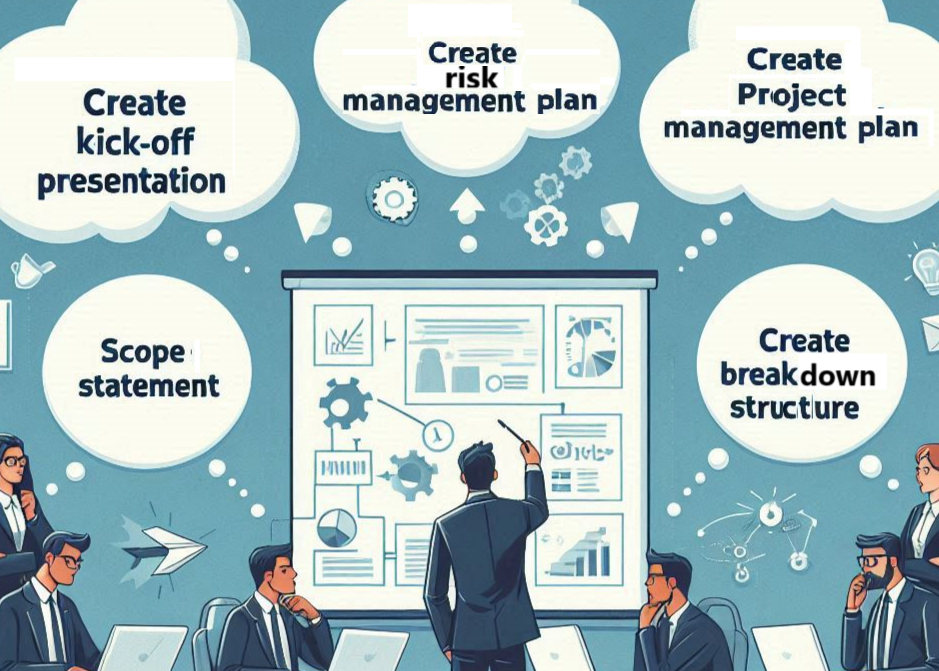
Project professionals seeking to leverage GenAI tools must understand both the science and art of prompt engineering. Developing these skills is essential for applying them effectively to different project management tasks. This article delves into how GenAI tools can be utilized during the Initiation phase of a project.
According to MIT, “Prompts are your input into the AI system to obtain specific results.” A well-constructed prompt can lead to an optimal response. In its simplest form, a prompt must include a context and an ask.
For example:
“I am new to project management and will be playing the role of Project Manager on a web software development project. Please suggest questions to ask during the project kick-off meeting.”
To get a more suitable response, it’s recommended to provide a broader context, including the environment, desired outcomes, and how the response will be used. The response can be further enriched by providing a relevant format or example to the GenAI tool. I’ve distilled the essential elements into the following prompt structure (a.k.a. syntax):
Prompt Syntax:
-
Act as a <persona>
-
In the context of <domain/industry> and <region>
-
Working on <type of project> and <task>
-
Require <desired outcome>
-
Response will be used <where> and <how> by <novice/practitioner/expert>
-
Having <format/structure>
-
Use this as an example: <example>
-
Provide source or references
Key Strategies for Conversation: Prompt Engineering Essentials for Project Managers (PMI)
-
Use a diverge and converge approach: Explore multiple ideas before narrowing them down.
-
Provide more context than you would to a human: AI benefits from extra details.
-
Give examples: Examples help clarify the ask and shape the AI’s response.
-
Make it a conversation, not a command: Build a dialogue with the AI tool for richer output.
-
Incorporate a reliability check: Always request references and sources.
Example: Fictional Project – Build a Customer Loyalty Program
We will illustrate how ChatGPT can assist in planning activities by using the fictional example of creating a customer loyalty program as a web software application to be completed in 6 months.
| # | Task | Sample ChatGPT Prompt | Observations & Comments |
|---|---|---|---|
| 1. | Setting the context | “Act as a Project Manager for a web software development project to build a customer loyalty program for consumer goods retailers. The project should be completed in 6 months.” | Providing context helps ChatGPT tailor responses accordingly, using role (Project Manager) and project nature (software development) as inputs to generate relevant content. |
| 2. | Create a Project Charter | “Create a project charter that identifies expectations regarding scope, schedule, quality, risk management, roles, responsibilities, assumptions, and dependencies.” | ChatGPT generates objectives, deliverables, a detailed scope (inclusion & exclusion), schedule milestones, risk management, and relevant assumptions and dependencies. |
| 3. | Create a Project Management Plan | “Create a project management plan using the project charter.” | The output includes sections on scope, schedule, cost, quality, risk, communication, and resource management. Each section describes how deviations will be handled. A project manager can adjust the plan to suit their organizational context. |
| 4. | Identify potential risks and response strategies | “List major risks and response strategies for the project in tabular format.” | The response includes risks like scope creep, technology challenges, resource availability, stakeholder feedback, and user adoption, along with impact, probability, and mitigation strategies. |
| 5. | Create a Project Scope Statement | “Create a detailed Scope Statement for the project.” | ChatGPT outlines common functionality for a typical customer loyalty management system, including exclusions, assumptions, deliverables, and acceptance criteria. The requirements document from the customer can be used to refine this further. |
| 6. | Create a Work Breakdown Structure (WBS) | “Use the scope document to create a hierarchical work breakdown structure, comprising software modules, epics, stories, and tasks to serve as input for project schedule planning.” | ChatGPT can break down the requirements or scope document into functional modules, epics, stories, and tasks, serving as a guide for project scheduling. |
